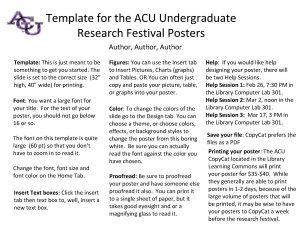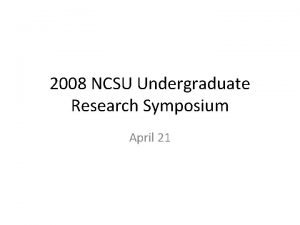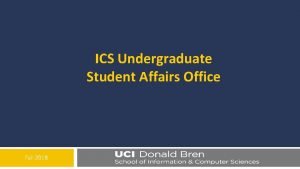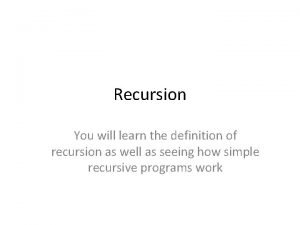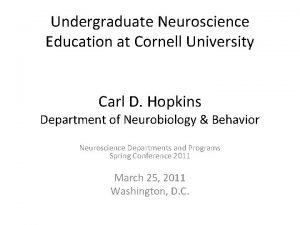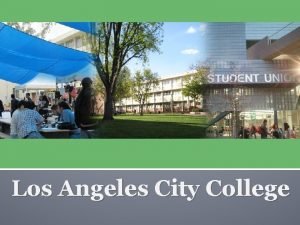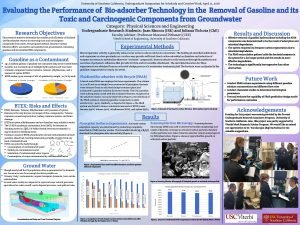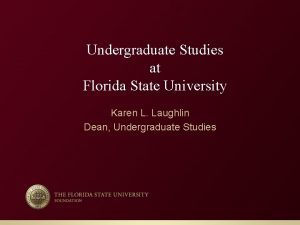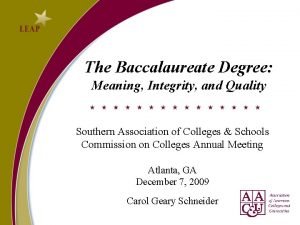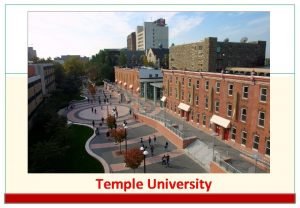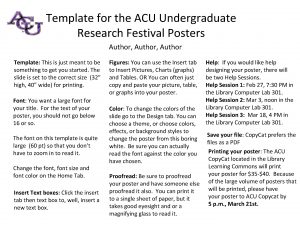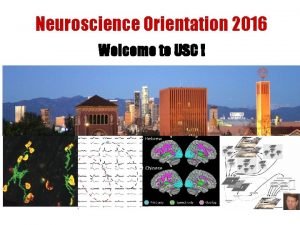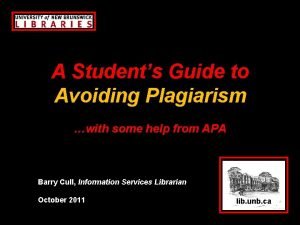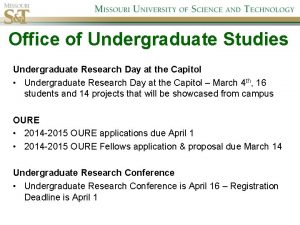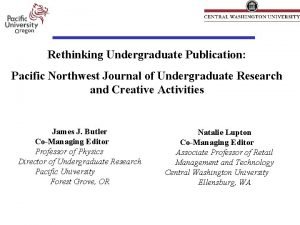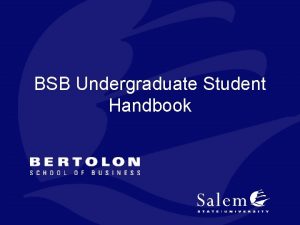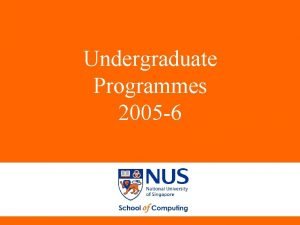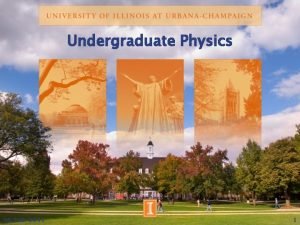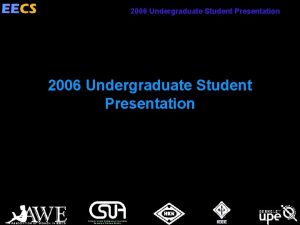THE OFFICE OF UNDERGRADUATE RESEARCH Creating Effective Research















































- Slides: 47

THE OFFICE OF UNDERGRADUATE RESEARCH Creating Effective Research Posters Presented by Kristie Durham Department of Linguistics Sponsored by the Office of Undergraduate Research University of Utah

THE OFFICE OF UNDERGRADUATE RESEARCH OUR Mission …to facilitate and promote undergraduate student-faculty collaborative research and creative works in all disciplines throughout the University of Utah campus. www. our. utah. edu

THE OFFICE OF UNDERGRADUATE RESEARCH Topics… • • Why present a poster? What is a poster session? What content should the poster include? What are some design considerations? Personalization… • Evaluate sample posters? • Getting started? • Peer review?

THE OFFICE OF UNDERGRADUATE RESEARCH Today we will use example posters from past OUR presenters. Please note that any criticism is a testament to the difficulty of poster design. Whether discussed or not, each poster presented also has excellent points!

THE OFFICE OF UNDERGRADUATE RESEARCH Why present a poster?

THE OFFICE OF UNDERGRADUATE RESEARCH Why present a poster? http: //admin. utah. edu/office_of_the_president/university-mission-statement

THE OFFICE OF UNDERGRADUATE RESEARCH Why present a poster? • Professional responsibility to disseminate research findings • Strengthen CV • Networking/Socialization • Develop your understanding of your own research! How?

THE OFFICE OF UNDERGRADUATE RESEARCH What is a poster session? University of Utah Undergraduate Researchers

THE OFFICE OF UNDERGRADUATE RESEARCH How is a poster presented? Presentation & Conversation!

THE OFFICE OF UNDERGRADUATE RESEARCH How is a poster presented? • Practice a TWO MINUTE presentation! • Practice speaking concisely about various sections of your poster • Practice, practice!

THE OFFICE OF UNDERGRADUATE RESEARCH How is a poster presented? • Greet visitors! • Probe interest and/or knowledge levels Carefully! • Offer to deliver your presentation

THE OFFICE OF UNDERGRADUATE RESEARCH Handling feedback & questions • Good feedback? Take notes. • Get contact information. To consider… • Undergraduate researchers can generally expect a supportive audience! • What kind of feedback is supportive?

THE OFFICE OF UNDERGRADUATE RESEARCH Difficult questions Question: I see you’ve chosen to use Method A, but don’t you think Method B would have been more appropriate? Possible responses: a. Could you tell me more about why Method A might be preferable to Method B? b. That’s an interesting possibility. I will need to give it more consideration.

THE OFFICE OF UNDERGRADUATE RESEARCH Create & Print the poster • Variety of software (Power Point) • Dimensions are conference specific • Printed by various office supply/print services: call ahead! TIP: Marriott Library Student Computing Service - Printing service, poster design guide, templates - Marriott Library>Knowledge commons>poster printing

THE OFFICE OF UNDERGRADUATE RESEARCH Marriott Library Poster Template Author 1, Author 2, Author 3 Department 1, Department 2, Department 3 University 1, University 2, University 3 ABSTRACT Do you need an abstract? METHODS • How did you do it and what did you use? • You can use references. • Think about using flowcharts and figures. LOGO CONCLUSIONS • List the major results. • Relate to the literature. • Discuss any new hypotheses and future work. INTRODUCTION • • Provides a brief background Gets the viewers interested Places work in the context of the literature Use bullets and graphics RESULTS/DISCUSSION • This is usually the largest section & can include your conclusions. • Include the analyzed data here in graphic format, equations, etc. • Include a brief summary of results and discussion. • The Presenter will be providing additional detail. REFERENCES • Use the format for your field of study • Reduce the amount of poster space used by: • Not including the title of the article • Listing only the 1 st author and then et al. ACKNOWLEDGEMENTS 48 inches wide X 36 inches high Acknowledge both the people: ACKNOWLEDGEMENTS • contributing to the research • the agencies funding the research, attendance at the conference, etc.

THE OFFICE OF UNDERGRADUATE RESEARCH What type of poster will you create? • Scientific • Creative

THE OFFICE OF UNDERGRADUATE RESEARCH Title, Authors & Affiliations Title: - Length 1 -2 lines - Informative - Avoid all capital letters Authors: - Include all authors & contact information - If photos, then professional appearance

THE OFFICE OF UNDERGRADUATE RESEARCH Title, Authors & Affiliations: - University, department, & research group - Website, email address - Logos (limited)

Intracranial Seizure Onset Zone Identification by Automated High-Frequency Oscillation Analysis in Patients with Intractable Epilepsy Michelle Reed 1 and Helen Barkan 2 1. Department of Bioengineering, University of Utah, Salt Lake City, UT, 84112 2. Department of Neurology, University of Utah, Salt Lake City, UT, 84112 Helen Barkan Michelle Reed Spectrogram Mean Rank Comparison A KNOWING WHERE TO PERFORM SURGERY FOR BEST PATIENT OUTCOME LEADS TO Percentage of Channels Chosen as Channels of Interest Using Spectrogram Methods CWT Mean Rank Comparison BB PROBLEM OF WHERE TO PERFORM NECCESSARY SURGERY: 30 -40% of patients with focal epilepsy have seizures that cannot be controlled with medications 1. Surgery removing the seizuregenerating areas is necessary to reduce seizure activity 2. Channels Figure 3 B: The Mean-Rank method shows more localization than the Frequency-Amplitude method for the CWT analyses. Using the Mean-Rank method for the Spectrogram and CWT data, 6 of 17 expert-localized seizure channels of interest were statistically significantly concordant with the signal processing methods. Channel 59 59 Raw Channel Raw. Data Mean-Rank Voltage (m. V) Patients had 1 -23 seizures analyzed using 36 -128 data channels recorded from intracranial electrodes Example intracranial electrode MATLAB’s “cwt” function’s placement coefficients output using the “sym 4” wavelet Time (s) MATLAB’s “spectrogram” function’s “P” power output Figure 1 A: The “Tukey's Honestly Significant Difference” test results for the spectrogram data shows that Channel 39 has the highest mean-rank compared to 89 of the 92 measured channels. Figure 1 B: The “Tukey's Honestly Significant Difference” test results for the CWT data shows that Channel 71 has the highest mean-rank of all 92 channels. Channel 59 CWT Absolute Value Coefficients Analysis CHANNELS OF HIGH-MEAN RANK or HIGHEST FREQUENCY Frequency (Hz) Channel 59 Spectrogram “Power” Analysis BECOME Frequency of Highest Amplitude per Channel for Spectrogram Analysis A Time (s) Averaging power per frequency across time to obtain an amplitude per frequency Averaging coefficients per scale frequency across time to obtain an amplitude per frequency Amplitude (Average CWT Coefficients) Amplitude (Average Power) Frequency (Hz) CHANNELS OF INTEREST Frequency of Highest Amplitude per Channel for CWT Analysis B Frequency between 80 -200 Hz 3 with the highest amplitude chosen to represent the channel Our research provides a method for determining channels of high-frequency content that are not immediately recognizable upon visual inspection of the raw data by an expert. The high percentage of channels determined by the Frequency-Amplitude method shows it to be a poor localizing technique, while the Mean-Rank technique is more localizing. Statistical analysis of the 17 expert-localized cases supports the nonrandom nature of the concordance with the signal processing methods. Acknowledgements Figure 2 A: The highest-amplitude frequency comparison for the Spectrogram analysis shows that Channels 8, 21, 22 and 28 had equal high-frequencies, indicating them as channels of interest. Frequency (Hz) Discussion Improvements to the current signal processing techniques will be researched to improve the success rate of the automated methods. Amplitude from CWT Frequency Analysis Amplitude from Spectrogram Frequency Analysis Percentage of Channels Chosen as Channels of Interest Figure 3 A: The Mean-Rank method shows more localization than the Frequency-Amplitude method for the Spectrogram analyses. Methods 27 patients gave consent to participate in the IRB approved study B Percentage of Channels Chosen as Channels of Interest Channels HIGH-FREQUENCY ANALYSIS TO DETERMINE “HOT” CHANNELS: We propose using the advanced signal processing techniques of Short-time Fourier Transforms (Spectrograms) and Continuous Wavelet Transforms (CWTs), combined with statistical analyses, to determine channels of interest using high-frequency oscillations. Percentage of Channels Chosen as Channels of Interest Using CWT Methods A Number of Seizure Files IDENTIFYING CHANNELS OF INTEREST FROM INTRACRANIAL RECORDINGS Results Number of Seizure Files Introduction Figure 2 B: The highest-amplitude frequency comparison for the CWT analysis shows that Channel 41 had the highest frequency, indicating it as a channel of interest. Undergraduate Research Opportunities Program Mayo Clinic References 1. Fujiwara H, et. al. Epilepsia. Sep; 53(9): 1607 -17. 2012. 2. Jacobs J, et. al. Ann Neurol. Feb; 67(2): 209 -20. 2010. 3. Worrell G, et. al. Biomark Med. Oct; 5(5): 557 -66. 2011.

THE OFFICE OF UNDERGRADUATE RESEARCH Abstract • Marriott Library Poster Template includes a section for an abstract • Do the abstract and the poster contain different content? • Abstract is textual, poster is visual

THE OFFICE OF UNDERGRADUATE RESEARCH Introduction • Concepts necessary to understand the research question • Importance or purpose of the work • Cite as necessary • State goals, hypotheses, objectives or research questions TIP: Visually highlight research questions!

Intrauterine Growth Restriction Alters Estrogen Signaling in Rat Adipose Tissue in a Sex Dependent Manner Danielle Holliday and Lisa Joss-Moore Department of Pediatrics Danielle Holliday Background Results Infants that do not grow appropriately in utero suffer intrauterine growth restriction (IUGR) IUGR Decreases Serum Estradiol in Male Adolescent Rats IUGR increases the lifelong risk of visceral obesity which predisposes to type II diabetes, cardiovascular disease and dyslipidemia Lisa Joss-Moore Estrogen Signaling Male Female Obesity is influenced by estrogen signaling Subcutaneous Adipose Tissue Visceral Adipose Tissue IUGR Increases ERα and ERβ in Male Rat Subcutaneous Adipose We hypothesize that IUGR will alter estrogen and estrogen receptors in rat adipose tissue in a sexand depot-dependent manner Male Female Methods Conclusion Estrogen Receptor α Pregnant IU GR E 0 E 19 Bi rt h Surgery (Bilateral Uterine Artery Ligation) P N 2 1 Estrogen Receptor β Ø In visceral adipose tissue of male rats, lower estrogen in combination with no change in estrogen receptor may decrease estrogen signaling and contribute to visceral obesity Ø Understanding the molecular origins of obesity in an animal model allows the development of targeted interventions that may be applied to human IUGR individuals IUGR Does Not Alter ERα and ERβ in Male or Female Rat Visceral Adipose Male Female Serum & Adipose Tissue (Subcutaneous and Visceral) Estrogen Receptor α * P<0. 05 Estrogen Receptor β n = 6 /group

THE OFFICE OF UNDERGRADUATE RESEARCH Methods • Participants (number, age, recruitment method) • Materials (stimuli, equipment, etc. ) • Procedures

Student Photo How engaging in mind-focused or body-focused eastern practices affects the way people narrate challenging events Grace Hanley and Monisha Pasupathi, Ph. D. Department of Psychology Grace Hanley Introduction Background • Research has shown that autobiographical writing is an effective tool to help individuals overcome difficult experiences and utilize memories in order to grow from challenging events [1]. Findings* Comparative Means Analyses: Narrative Coding: Transgressions Example of a highly explorative narrative: “I used to be a bit over weight [sic] in high school and often people made fun of me. I'm a sensitive person but I didn't let it get to me at the time. I have lost a lot of weight since then and most people I have ran into from high school seem to not recognize me at all…I don't feel hurt about it but it just makes me realize that negative comments come back to haunt you no matter how far ahead in life you get and that makes me feel sorry for all the people I have hurt by saying something rude unintentional [sic]. ” information, vividness, and emotional details in stories, thus hindering explorative storytelling [1]. • Eastern practices shown to reduce anxiety and depression [2, 3]. • Yoga and meditation can potentially encourage exploration in narratives, which is attributed to increased mental well-being. Example of a highly non-explorative narrative: • Hypothesized that yoga and meditation could influence how 0 1 2 3 4 “When my mom called me ugly and my little sister support [sic] her comment by saying that I was ugly as well. ” 5 Degree to which participants reported growth and affect based on a 0 to 5 scale. Questions Addressed • Do mindfulness practices increase instances of emotional Applications With Traumatized Individuals, Including Military Personnel: Yoga shown to significantly Victimizations exploration, growth, and resolution in narratives? reduce cortisol levels (an indicator of stress) in groups of male military personnel over the course of six months [4]. • Are measures of self-compassion, forgiveness, well-being, and interoceptive awareness correlated with the previously mentioned mechanisms? Other studies, however, haven’t shown as dramatic of changes in cortisol levels due to yoga treatment [2, 4], indicating that subjects themselves (military personnel) already have increased levels of cortisol at their individual baselines. Perhaps they are more receptive to alternative treatments that lower it than nonmilitary individuals [4]. • Are there word usage differences across experiment conditions? Methods Participants 80 undergraduates recruited via the CSBS participant pool; average 21. 27 (SD =3. 931); 51 females, 28 males. Materials and Measures • • • Story prompts by the Foley Center for the Study of Lives Transgression-Related Interpersonal Motivations Inventory Ryff Scale of Psychological Well-Being Self Compassion Scale Multidimensional Assessment of Interoceptive Awareness Procedure s component: subjects participated in one of four possible 10 First 15 minute activities: a yoga sequence, an exercise regime, a meditation, or watching a series of neutral pictures. Second component: subjects asked to narrate three types of life events: two transgressions, two victimizations, and two life turning points. Afterwards, participants were asked to complete several questionnaires about themselves. Dr. Monisha Pasupathi Future Directions • Individuals who have depression or anxiety often lack contextual individuals process and narrate difficult experiences from the past. Faculty Photo 0 1 2 3 4 Degree to which participants reported growth, exploration, and affect based on a 0 to 5 scale. 5 *Due to the nature of this study, preliminary findings are based on a portion of the data at hand. Discussion Affect: Yoga (and to a lesser degree, meditation) shown to alleviate negative affect associated with transgressions. Unexpectedly, exercise appears to have a stronger, positive effect on transgressions. Exploration: Yoga shown to have a stronger effect on the degree to which participants report exploration of victimizations. Growth: Yoga shown to foster perceived growth in participant transgressions and victimizations. Over Spring 2014, narratives will be coded for exploration, growth, and resolution using the Coding System for Components of Transformational Processing [ 1 In order to further study the applicably of Eastern practices as therapeutic tools, it would be beneficial to use groups susceptible to high stress and traumatic events (e. g. , military personnel, ethnic minorities, victims of abuse, drug addicts) compared to lower risk populations. Selected References [1] Pals, J. L. (2006). Narrative identity processing of difficult life experiences: Pathways of personality development and positive self-transformation in adulthood. Journal of Personality, 74(4), 1079 -1110. [2] Woolery, A. , Myers, M. A. , Sternlieb, B. , & Zeltzer, L. (2004). A yoga intervention for young adults with elevated symptoms of depression. Alternative Therapies in Health and Medicine, 10(2), 60 -63. [3] Woodyard, C. (2011). Exploring therapeutic effects of yoga and its ability to increase quality of life. Internal Journal of Yoga, 4(2), 49 -54. [4] Rocha, K. K. , Riberio, A. M. , Rocha, K. C. , Sousa, M. B. , Albuquerque, F. S, Riberio, S. , & Silva, R. H. (2012). Improvement in physiological and psychological parameters after 6 months of yoga practice. Consciousness and Cognition, 21(2), 843 -850.

THE OFFICE OF UNDERGRADUATE RESEARCH Results • Analyzed data • Present findings in labeled tables, charts, graphs, etc. • Use concise text to orient visitors: – Explain graphs – How do different findings relate to one another – Highlight key findings


THE OFFICE OF UNDERGRADUATE RESEARCH Discussion/Conclusions Clearly and concisely… • Identify key findings • Interpret these findings • State any remaining questions/future directions Consider. . . • Do the findings answer the research questions? • Is the importance of the work clear?


THE OFFICE OF UNDERGRADUATE RESEARCH References & Acknowledgments • Cite sources! • Use appropriate style in references • Acknowledgements are important: - Credit funding sources - Credit colleagues who have contributed time, feedback or ideas

THE OFFICE OF UNDERGRADUATE RESEARCH References & Acknowledgments

THE OFFICE OF UNDERGRADUATE RESEARCH Scientific Posters • Should scientific posters have the exact headings introduction, methods, results, etc. ? • Is the three-column format necessary? • Any questions or comments?

THE OFFICE OF UNDERGRADUATE RESEARCH Creative Posters • • Introduction Methods Results Summary/Conclusions (Discussion)

THE OFFICE OF UNDERGRADUATE RESEARCH Creative Posters • Authors, Title and Affiliations • Introduction (purpose of work) • Methods (what was done) • Results & Conclusions (what was found and why it matters) • References & Acknowledgments

THE OFFICE OF UNDERGRADUATE RESEARCH Tell the story with… • • Thematic headings Visual anchors for thematic sections Visual Metaphor Text as visual element


THE OFFICE OF UNDERGRADUATE RESEARCH Visual Metaphor https: //www. uhd. edu/academic/colleges/sciences/scholars/files/workshop-poster. pdf

THE OFFICE OF UNDERGRADUATE RESEARCH Text as Visual Element https: //www. uhd. edu/academic/colleges/sciences/scholars/files/workshop-poster. pdf

THE OFFICE OF UNDERGRADUATE RESEARCH Other general design considerations Text/Font should… • Conform across similar sections in size and color • Be concise and easily read: – Avoid long sentences – Use bullets or other markers

THE OFFICE OF UNDERGRADUATE RESEARCH Other design considerations Color should… • Be purposeful • Be consistent • Draw attention to different sections of poster (white space) • Provide sufficient contrast Graphics & Images should… • Communicate meaning • Be informative rather than entertaining

THE OFFICE OF UNDERGRADUATE RESEARCH Other design considerations Finally… • Use whitespace to direct attention • Plan a logical order for poster elements • Make the order transparent (headings, left-toright)

THE OFFICE OF UNDERGRADUATE RESEARCH • http: //www. nature. com/naturejobs/scien ce/articles/10. 1038/nj 7387 -113 a

THE OFFICE OF UNDERGRADUATE RESEARCH Questions?

Jordan Fenlon Mutational Analysis of the Serine Chemoreceptor in Escherichia coli Jordan Fenlon and John S. Parkinson Department of Biology E. coli movement is controlled by flagellar rotation. Faculty Photo John S. Parkinson Tsr controls flagellar motors via a phosphorelay pathway. Tsr is a chemoreceptor that controls flagellar motors in response to serine. no chemoeffector gradient: random walk receptor signaling states amino acids and sugars attractant gradient: biased random walk A 413 is an alanine residue important in Tsr signaling function. Amino acid replacements at residue A 413 can change Tsr function due to size and charge differences. measuring the signaling properties of mutant Tsr receptors by Fluorescence Resonance Energy Transfer (FRET) diffusible motor control signal two-state signaling model for mutant A 413 chemoreceptors signaling reaction controlled by Tsr channel plots from a FRET experiment plot showing SER-induced changes in kinase activity Tsr signaling activity detected by FRET hardware for measuring donor and acceptor emissions dose-response properties of some mutant receptors Structural changes at Tsr residue A 413 damage signaling behavior by shifting output toward the kinase-ON or kinase. OFF state. These experiments were done in a cell strain that lacked sensory adaption ability. Now I need to test the ability of these mutant receptors to undergo sensory adaptation.

Metabolic Impacts of Cigarette Smoke on RPE and Muller Cells of Complement Compromised Mice Alexandra D. Butler and Bryan W. Jones Ophthalmology Alexandra D. Butler Bryan W. Jones Purpose Age-related macular degeneration (AMD) is one of the largest causes of blindness worldwide. Cigarette smoking is known to be the single largest risk factor for AMD, aside from age. Several of the main genetic risk factors for AMD are polymorphisms occurring in complement genes involved in the alternative, classical and common terminal pathways. To better understand the metabolic impact of smoking on the retina, computational molecular phenotyping (CMP) was used to examine the effects of cigarette smoke on wild type (WT) mouse retinas and retinas of mice in which either the alternative pathway (complement factor B, Cf. B) or the common terminal pathway (complement component 3, C 3) was removed. Specifically, Müller Cells, Retinal Pigment Epithelium (RPE), and photoreceptor Inner and Outer Segments were examined across the aforementioned conditions. 1 a 1 b Background AMD Shown above are images of a normal human retinal fundoscopic exam illustrating normal color, pigment and vascular distribution (1 a), and a human fundoscopic image showing classic extensive drusen commonly observed in AMD (1 b). Drusen contain numerous proteins associated with the compliment cascade, related to the process of inflammation or its aftermath. Research has shown that the complement cascade is involved in AMD. Recent research by De. Angeles, Curcio, Hageman and others has shown that AMD may not necessarily be a disease of the retina, but that retinal tissue manifests the disease in response to systemic insults. We are interested in how these effect may be visible in retinal metabolic measures and in particular, the AMD retina. As there are no accepted models of AMD with drusen, we focused on the biggest risk factor for AMD, smoking. Complement Cascade: The 2 a complement system assists the immune system in clearing pathogenic antigens from the body. Complement can be recruited through three separate pathways: the classical, lectin, and alternative pathways (2 a). Activation of the classical and lectin pathways results in inflammation, chemotaxis, cell lysis, membrane attack phagocytosis process through a feedback or amplification loop of the opsonization process or complex (MAC) enhancing the phagocytosis of antigens. activation, and other Removal of C 3 eliminates all biological effects of the complement system (2 b). Removal of aspects associated Cf. B eliminates the amplification loop that generates the full-blown complement attack (and the with immune spontaneous turnover and initiation by the alternative pathway, but it isn’t yet known what role responses. The this plays in the eye) (2 c). We have not yet found anything that is purely dependent upon the alternative pathway. enhances the 2 b 2 c Methods While smoking is common, obtaining post-mortem tissues from human subjects in a timely fashion is problematic. Therefore, in collaboration with Dr. Baerbel Rohrer’s laboratory at the Medical University of South Carolina (MUSC), we examined the effect of cigarette smoke on the mouse eye. The mouse eye is remarkably similar to the human eye, with very similar small molecular values in retinal tissues, and serves as a reasonable model for this evaluation. Another advantage of a mouse model is that it allows for alterations in the gene sequence, letting us look at the alterations in the complement cascade and compare WT, Cf. B knockout, and C 3 knockout mice. Mice were exposed to cigarette smoke generated using an automated cigarette-smoking machine (Model TE-10, Teague Enterprises, Davis, CA) burning 3 R 4 F reference cigarettes (2. 45 mg nicotine per cigarette). Mice were exposed for 6 hours/day, 5 days/week for 6 months. Age matched room filtered air exposed mice were used as controls. Eyes were enucleated immediately post-mortem, fixed in 1% paraformaldehyde, 2. 5% glutaraldehyde, dehydrated in graded methanol, embedded in eponates as stacks of 6 and thin sectioned at 180 nm into 10 well glass slides. Slides were probed with antibodies generated against small molecules of interest and 3 a histologically analyzed with CMP. Signals were detected and intensified with silver, then digitally captured. The captured images were registered and clustered to mask out specific cell classes for quantitative statistical analysis. Unsupervised clustering methods, like k-means clustering, allow us to deal with complex data and segment it into manageable classes that can provide statistical measures of separability. We can then focus in on different mathematical cell classes. Here we have considered Photoreceptor Inner Segments (blue), Outer Segments (yellow), RPE (green), and Müller Cells (red) (3 a). Both Müller Cells and RPE of WT smoked retinas demonstrated changes relative to non-smoked retinas. In RPE, non-smoked C 3 and Cf. B knockout samples showed decreases in D, E, J, R, TT, and YY compared to non-smoked WT. Smoking resulted in increases across these small molecules for C 3, while Cf. B showed no change, or further decreases when compared to non-smoked samples. In the Müller Cells, similar to RPE, C 3 and Cf. B knockouts showed decreases in GS, Smoked C 3 had some increase in these levels, nearing original non-smoked WT levels, and R, TT, and YY relative to WT samples. smoked Cf. B showed little-to-no changes, or further decrease. Separate from the shifts in small molecule levels, the variance of metabolic signals within Müller Cell class increased. Under pathological conditions, like exposure to cigarette smoke or modifications to the functionality of the immune system, cell populations normally described by narrow small molecule signal profiles become more disorganized. Signal variance of CRALBP, E, G, J, Q, and TT increased in both non-smoked knockouts relative to WT samples. However, under smoked conditions, the variance of these small molecules in the C 3 samples decreased, while that of Cf. B knockouts continued to increase. This indicates a disruption, to some degree, of the mechanisms regulating those small molecule levels and the cells stress response pathway, particularly under the smoked Cf. B knockout condition. Results Shown below are some images taken from a wild type mouse that has been exposed to cigarette smoke (4 a). The sections are cut thin enough so that each one of the labels shows signals of molecules from the same cells. This allows for determination of signals of each cell type across experimental conditions. 4 a Alterations in retinal small molecule signatures were observed in smoked retinas compared to nonsmoked retinas from mice in WT, Cf. B knockout, and C 3 knockout conditions. Histograms were then created from the grey-scale profile for the cell class of interest, which can be used to analyze signal densities of the molecules of interest. These are log plots on the horizontal axis, so small differences are actually substantial. Shown are the concentration profiles for the Inner Segments, Outer Segments, Müller Cells, and RPE. Plots of particular interest or significance are indicated by a green asterisk (*). Inner and Outer Segments of WT smoked retinas both demonstrated changes in small molecule levels relative to non-smoked retinas. In the Inner Segments, the complete complement, C 3 knockout, mice had the more dramatic effects, whereas the Cf. B mice showed more restrained changes. This pattern was especially evident in D, E, J, Q, R, TT, and YY. This is a predictable response, as the increased inhibition of the complement cascade would be expected to create more dramatic alterations to cell stress response pathways. In the Outer Segments, signal changes between non-smoked and smoked conditions in D, E, J, Q, R, and TT progressively increased in the retinas of WT, C 3, and Cf. B knockout mice indicating increased response profiles to cell stress. The fact that there are significant differences in the outer segments is surprising given how little room there is in a presumptive normal outer segment for anything other than rhodopsin. Cf. B knockout mice seem to have the most dramatic effect on cell stress response pathways in the outer segments. This is somewhat paradoxical, as the more complete inhibition of the complement cascade in the C 3 knockout would be expected to have a more dramatic effect that the Cf. B knockout of the feedback loop. Conclusions In response to cigarette smoke exposure; we see substantial metabolic changes in photoreceptors. Glutamate, glutamine, glutathione and taurine are known to be involved in cell stress response & osmoregulation. Glutamine and glutathione increased in photoreceptor cells upon smoke exposure. Eliminating essential components of the complement system, a cascade required for the maintenance of the immune privilege of the eye, appears to exacerbate responses to cigarette smoke in oxidative damage response related pathways. The complete blockade of the complement system via the common terminal pathway (C 3 knockout) has a more substantial impact on the inner segments or photoreceptor cell bodies than a partial blockade of the complement system via the alternative pathway (Cf. B knockout). The importance of the RPE cannot be understated in the maintenance of photoreceptors while Müller Cells are perhaps best positioned to respond to environmental insults. Glutathione and glutamine are up-regulated in cells undergoing cellular/oxidative stress while arginine upregulation may reveal alterations in gene expression as cells alter metabolism to stabilize gene translation. The changes we see in the Müller Cells and RPE of the levels of these small molecules, and of signal variance, seem to indicate that there is some response to the oxidative stress of cigarette smoke that is functional in the C 3 knockout that is disabled in the Cf. B knockout. Furthering our understanding of complement-dependent metabolic alterations in the eye might aid in our understanding of AMD pathology and may open new avenues for novel treatment strategies.

Cardiac Reinnervation In Heart Transplant Recipients Assessed By Mechanoreceptor Stimulation Fumina Kobayashi, Dr. Melissa A. H. Witman, and Dr. Russell S. Richardson Department of Exercise and Sport Science ABSTRACT: With increasing survival rates and longevity of heart transplant (HTx) recipients, quality of life post-HTx is of growing importance. HTx results in complete denervation of the heart which contributes to limited exercise capacity and difficulty performing some activities of daily living. Although, with time post-HTx, reinnervation has been suggested, there is little functional evidence to support this concept. PURPOSE: Using passive leg movement (PLM), a model that isolates type III mechanoreceptors and stimulates a heart rate (HR) response, this study sought to gather evidence of cardiac reinnervation in a population of HTx recipients with time following transplantation. METHODS: Measurements of HR were recorded during PLM in 39 HTx recipients (62 ± 2 yrs) that ranged from 1 month to 27 years post-HTx and 10 healthy age-matched controls (60 ± 3 yrs). RESULTS: The HR response to PLM was significantly attenuated in the HTx recipients (3 ± 2 bpm, Δ 1 %) compared to the controls (7 ± 1 bpm, Δ 13 %). However, there was no relationship between the time post-HTx and HR response, whether measured as maximum HR, absolute change from baseline, or percent change from baseline. CONCLUSION: Despite the inclusion of a large cohort of HTx recipients with a wide range of times post-HTx, these data do not provide any evidence of functional cardiac reinnervation in this population. METHODS: Participants: Thirty-nine HTx recipients and ten healthy agematched controls were recruited either by word of mouth or in the HTx clinics at the University of Utah and the Salt Lake City VA Medical Center. The protocol was approved by both institutions and written informed consent was obtained from all participants. Procedure: Subjects rested supine for approximately 20 minutes prior to the start of data collection and remained in this position throughout the entire protocol. The protocol consisted of a 60 second resting baseline followed by a two minute session of passive leg extension. The passive exercise was achieved by moving the subject’s lower leg through a motion of 90 to 180 degree knee joint angle at a rate of 1 Hz. A metronome was used to maintain cadence. Throughout the protocol heart rate form the Finometer (Finapres Medical Systems BV, Amsterdam, The Netherlands) underwent A/D conversion and was simultaneously acquired (200 Hz) using commercially available data acquisition software (Acq. Knowledge, Biopac Systems). Dr. Russell Richardson Figure 1. Methodology utilized during passive leg movement (PLM). Table 1. Subject Characteristics Variable N Age, yrs Weight, kg Height, cm Body mass index, kg/m² Systolic blood pressure, mm. HG Diastolic blood pressure, mm. HG Controls 10 60 ± 3 82 ± 3 176 ± 2 26 ± 1 126 ± 3 80 ± 2 HTx 39 62 ± 2 89 ± 3 175 ± 2 30 ± 2 124 ± 3 78 ± 2 Figure 2. The relationship between time post-heart transplant (post-HTx) and heart rate (HR) response. Data are mean ± SE. HTx indicates heart transplantation. Table 2: Characteristics Pertinent to the HTx Recipient Groups Variable N Months post-HTx Diagnosis, ischemic cardiomyopathy Diagnosis, nonischemic cardiomyopathy Left ventricular ejection fraction, % Diabetic, No. of all cases Medication, No. of all cases Cyclosoporine Tacrolimus Azathioprine Mycophenolic Acid Sirolimus Prednisone Beta-blocker ARB ACE - Inhibitor Statin Diuretic Calcium channel-blocker Alpha-blocker HTx 39 106 ± 14 22/39 17/39 62 ± 1 19/39 18/39 5/39 26/39 5/39 16/39 14/39 6/39 17/39 34/39 12/39 16/39 10/39 Data are mean ± SE. HTx indicates heart transplantation; ARB, angiotensin II receptor blocker; ACE, angiotensin-converting enzyme. Figure 3. Heart rate (HR) response expressed in absolute change (A) and percent change from baseline (B) in controls and heart transplant (HTx) recipients. CONCLUSION: No relationship between the time post-HTx and the HR response, whether measured as maximum HR, absolute change from baseline, or percent change from baseline HR response to PLM is reduced in the HTx recipients compared to controls These data do not reveal any evidence of cardiac reinnervation in the HTx recipients

Adam M. Blair HISTONE MODIFICATIONS ARE ALTERED IN THE RENAL CORTEX OF VENTILATED PRETERM LAMBS Adam M. Blair and Kurt H. Albertine Division of Neonatology Lamb to human age equivalence PT 3 d IMV PT 3 d HFNV Former PT Term+15 wk Faculty Photo Kurt H. Albertine Supported by HL 110002 HL 062875 Bangerter-Foundation, Switzerland University of Utah UROP Assistantship

THE OFFICE OF UNDERGRADUATE RESEARCH Contact Us Kristie. Durham@Utah. edu info@urop. utah. edu www. our. utah. edu Thank you!
 Victoria olsen
Victoria olsen Acu undergraduate research festival
Acu undergraduate research festival Michael flavin
Michael flavin Ncsu undergraduate research symposium
Ncsu undergraduate research symposium Undergraduate meaninh
Undergraduate meaninh Portland state university tuition
Portland state university tuition Ics academic advisor
Ics academic advisor Undergraduate graduate postgraduate
Undergraduate graduate postgraduate Definition of undergraduate student
Definition of undergraduate student Difference between postgraduate and undergraduate
Difference between postgraduate and undergraduate Difference between postgraduate and undergraduate
Difference between postgraduate and undergraduate Cornell nbb
Cornell nbb Los angeles city college undergraduate enrollment
Los angeles city college undergraduate enrollment Acadia university undergraduate programs
Acadia university undergraduate programs University of southern california
University of southern california Dean of undergraduate studies fsu
Dean of undergraduate studies fsu Csub nursing program
Csub nursing program What is an undergraduate degree
What is an undergraduate degree Temple university undergraduate bulletin
Temple university undergraduate bulletin Acu copycat
Acu copycat Usc neuroscience
Usc neuroscience Unb undergraduate calendar
Unb undergraduate calendar Word module 2 creating a research paper
Word module 2 creating a research paper Hát kết hợp bộ gõ cơ thể
Hát kết hợp bộ gõ cơ thể Slidetodoc
Slidetodoc Bổ thể
Bổ thể Tỉ lệ cơ thể trẻ em
Tỉ lệ cơ thể trẻ em Gấu đi như thế nào
Gấu đi như thế nào Tư thế worm breton là gì
Tư thế worm breton là gì Hát lên người ơi alleluia
Hát lên người ơi alleluia Các môn thể thao bắt đầu bằng tiếng chạy
Các môn thể thao bắt đầu bằng tiếng chạy Thế nào là hệ số cao nhất
Thế nào là hệ số cao nhất Các châu lục và đại dương trên thế giới
Các châu lục và đại dương trên thế giới Công thức tính độ biến thiên đông lượng
Công thức tính độ biến thiên đông lượng Trời xanh đây là của chúng ta thể thơ
Trời xanh đây là của chúng ta thể thơ Cách giải mật thư tọa độ
Cách giải mật thư tọa độ 101012 bằng
101012 bằng độ dài liên kết
độ dài liên kết Các châu lục và đại dương trên thế giới
Các châu lục và đại dương trên thế giới Thơ thất ngôn tứ tuyệt đường luật
Thơ thất ngôn tứ tuyệt đường luật Quá trình desamine hóa có thể tạo ra
Quá trình desamine hóa có thể tạo ra Một số thể thơ truyền thống
Một số thể thơ truyền thống Bàn tay mà dây bẩn
Bàn tay mà dây bẩn Vẽ hình chiếu vuông góc của vật thể sau
Vẽ hình chiếu vuông góc của vật thể sau Thế nào là sự mỏi cơ
Thế nào là sự mỏi cơ đặc điểm cơ thể của người tối cổ
đặc điểm cơ thể của người tối cổ V cc
V cc Vẽ hình chiếu đứng bằng cạnh của vật thể
Vẽ hình chiếu đứng bằng cạnh của vật thể

